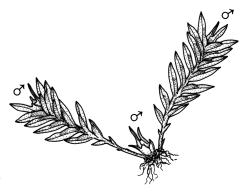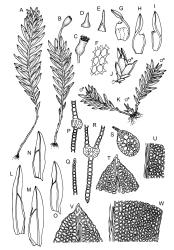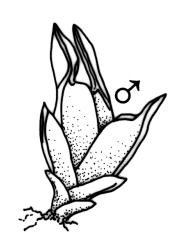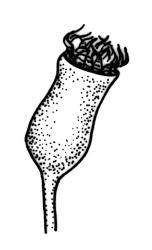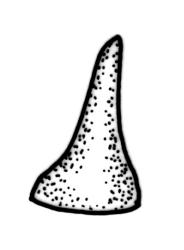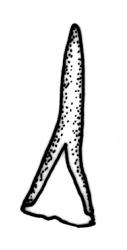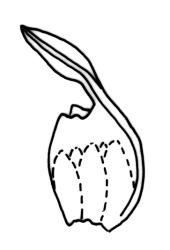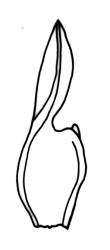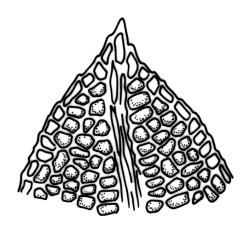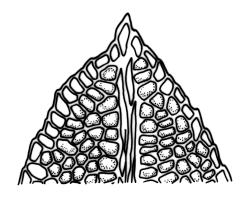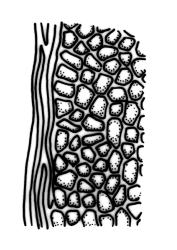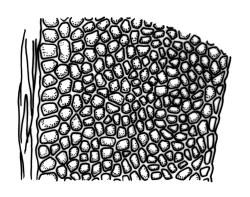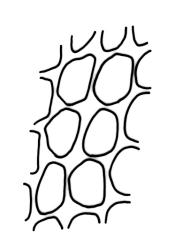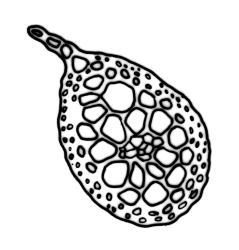Fissidens anisophyllus sensu Sainsbury 1955, pro parte.
Specimens of F. blechnoides have been referred erroneously to F. anisophyllus Dixon, owing to confusion promulgated by both Dixon (1923) and Sainsbury (1955) (see under the latter species).
Plants 10–16 mm, yellow-green to dark green, in scattered clusters or densely gregarious. Stems simple, with rhizoids at base only. Leaves in 6–15(–23) pairs, scarcely overlapping at mid stem, patent, decurved when moist, little altered when dry, oblong-lanceolate, 1.0–1.6 × 0.3–0.4 mm; apex acute to broadly acute, sometimes mucronate; laminae unistratose; vaginant laminae ½–⅔ leaf length, open; dorsal lamina reaching leaf insertion and shortly decurrent on stem; margins minutely serrulate on dorsal and apical laminae, serrulate near leaf apex, entire on vaginant laminae; marginal cells on vaginant laminae only distinct in several rows, thick-walled, prosenchymatous, and forming a well-defined unistratose border confluent with the costa at mid leaf; cells of apical and dorsal laminae quadrate to hexagonal, smooth, moderately bulging, with moderately thick walls, (4.5–)7.5–10.5(–12.0) × (4.5–)7.5–10.5(–12.0) µm. Costa percurrent, bryoides-type in cross-section.
Dioicous. Perichaetia terminal; perichaetial leaves longer and narrower than vegetative. Perigonia terminal on tall plants (up to 12 pairs of leaves) or bulbiform near base of male plants. Setae yellow to light-brown, wiry, 2–3 mm; capsules erect to inclined, symmetric, 0.6–1.0 mm; operculum obliquely rostrate from a conic base, c. ½ the length of theca. Peristome bryoides-type; teeth with adaxial trabeculae below the bifurcation either smooth or bearing a few short-columnar papillae, 50–70 µm wide at base. Calyptra smooth, cucullate. Spores 14–21 µm.
Beever 1996, figs 1–2; Beever et al. 2002, p. 20, figs 1–6.
Fissidens blechnoides is distinctive in the disposition of borders on the leaf margins, and in the lack of variability in this character: borders are moderately stout, strictly confined to the vaginant laminae (which are open in all leaves), and confluent with the costa at the apex of the minor vaginant lamina. In contrast, in F. anisophyllus borders are variable, but usually present on dorsal, apical and vaginant laminae (the vaginant laminae usually being partially closed or closed on vegetative leaves) and not confluent with the costa.
Fissidens blechnoides is also sometimes confused with F. megalotis subsp. megalotis (which also has open vaginant laminae) but in that species the dorsal and apical laminae are bordered to near the leaf apex, and the laminal cells are often obscured by low papillae. In addition, shoots of F. blechnoides are little altered when dry, while dry shoots of F. megalotis subsp. megalotis are inrolled at their apices.
There are similarities to the African F. marginatus Müll.Hal., which has open vaginant laminae on every leaf, but that species differs from F. blechnoides in the presence of a border on apical and dorsal laminae, and a strongly asymmetric capsule.
A particularly notable feature of F. blechnoides is the strictly lateral heterostichy of its shoots.
NI: N Auckland, including offshore islands (HC, LB), S Auckland, Gisborne, Hawke’s Bay, Taranaki (Rotokare), Wellington (including KA); SI: Nelson (including D’U), Marlborough, Canterbury, Westland, Otago; St; Ch.
Endemic.
Fissidens blechnoides occurs scattered through both main islands and on the larger offshore islands, with records from latitude 35° 04' (Kaitāia) to 47° 07' S (Rakiura/Stewart I.). It is uncommon in the north of the North I., where it is usually found growing in small isolated clumps. Further south it grows abundantly, often forming extensive pure swards.
Almost always on soil, rarely on rock (schist), occasionally as a low epiphyte in stream flood zones or swamps, with the substrate visibly silted. Most commonly on steeply sloping banks, in shaded and mesic sites. Usually in indigenous forests, but also in exotic vegetation including urban parks. At the type locality it grows on uplifted Pleistocene greywacke gravels (Moutere gravels), shaded in southern beech forest (Fuscospora fusca, F. solandri, and Lophozonia menziesii) with occasional emergent podocarps. Fissidens blechnoides is commonly mixed with other species of Fissidens, most frequently with F. asplenioides, F. curvatus, F. leptocladus, and F. tenellus; less often with F. dealbatus (in damper sites only), F. linearis var. angustifolius, F. pallidus or F. taxifolius. Other moss associates from mesic sites are Catagonium politum, Hypnum cupressiforme and Thuidiopsis sparsa, while associates in wetter sites include Achrophyllum dentatum, A. quadrifarium, Distichophyllum microcarpum, and Plagiomnium novae-zealandiae.
Recorded from near sea level to 630 m (Camp Creek, Westland L.D.).
An account of F. blechnoides in N.Z. was given by Beever (1996).



